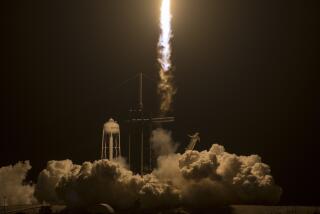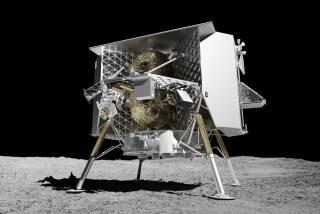Propellant Failure May Have Caused Explosion of Titan
- Share via
Air Force investigators suspect that the explosion that destroyed a Titan 34-D rocket and its secret cargo Friday was caused by the cataclysmic failure of the propellant in one of the Titan’s two solid rocket boosters, according to a source close to the investigation.
That tentative conclusion is based largely on the fact that the sequence of events Friday was nearly instantaneous, thus virtually ruling out the chance that the explosion was caused by a leak in a joint in one of the solid rocket boosters. Much speculation has centered on the seams because a leak through a seam in a booster is believed to have caused the Jan. 28 explosion that destroyed the space shuttle Challenger.
The secret Titan investigation has already made considerable progress, although it could be months before the cause of the fierce blast is known for certain, according to the source, who spoke only on the condition that he not be identified.
The Titan exploded five seconds after lifting off from Vandenberg Air Force Base, destroying a payload that has been widely reported to be a crucial KH-11 photo reconnaissance satellite. However, a Pentagon source told The Times Tuesday that the Titan was not carrying the KH-11.
The nature of the payload thus remains a mystery, but investigators have been getting much closer to the cause of the explosion, according to an aerospace engineer who is familiar with the evidence being collected by the Air Force investigators.
The evidence, including “very good pictures,” has all but ruled out the possibility of a joint failure on one of the rockets, or of detonation of the Titan’s self-destruct device.
“There must have been some kind of irregularity in the propellant itself,” said the source.
The texture and composition of solid rocket propellant must be extremely consistent in order for the fuel to burn evenly. An inconsistency could cause “hot spots,” which could burn through the side of the rocket. But the explosion of the Titan was so powerful that investigators believe that the problem was far more serious.
‘An Instantaneous Blow’
Rather than a slow leak, like the one that destroyed the Challenger, “It was actually an instantaneous blow,” said the source.
The technical term for the type of failure sustained by the Titan’s booster is a “deflagration,” the engineer added.
“That usually occurs because of instantaneous high pressure” brought about by some major problem within the propellant itself, he said.
The rocket exploded at 10:45 a.m. Friday, sending a toxic cloud along the coastline. It was the second loss in a row of Titans launched from the sprawling base, although for different reasons.
On Aug. 28, a Titan believed to be carrying a KH photo satellite failed to reach orbit when one of its two main liquid-fueled engines suddenly shut down. The rocket was destroyed by range safety officers.
The August failure occurred after the solid rocket boosters had separated from the Titan, so they could not have figured in the cause.
Convincing Evidence
Friday’s explosion occurred when only the solid boosters, which are strapped to the main assembly, were running. The liquid-fueled engines are not fired until 108 seconds into the flight.
Although the Air Force has refused all comment on the investigation into Friday’s accident, investigators have uncovered some convincing evidence about what caused the explosion, and they have been able to rule out some theories, according to the source who is familiar with the evidence.
The evidence includes “pretty good pictures” that show the explosion was instantaneous rather than a progressive series of events, he said. It is also possible to rule out the chance that the rocket was inadvertently or intentionally destroyed by its self-destruct explosive charges.
Solid rockets are armed with linear, self-destruct charges designed to rip the rockets apart on command from range safety officers. But since the charges run the full length of the 90-foot-tall boosters, a linear pattern should have been evident in photographs of the blast.
‘Irregularity in Propellant’
Instead, the photographs show a massive, instantaneous explosion rather than a linear pattern, said the source.
That has left investigators leaning strongly toward the theory that the explosion was caused by an “irregularity in the propellant itself,” he added.
David Altman, a retired engineer from the Chemical Systems Division of United Technology Corp., which built the Titan’s boosters, said he also doubted that a faulty seam caused the explosion because such a failure would not have caused an explosion for at least 10 seconds.
The company declined to comment Tuesday.
Although he said he had no direct knowledge of the investigation, Altman also questioned whether major irregularities in the propellant would cause an instantaneous buildup of pressure within the booster, leading to the deflagration.
“It wouldn’t happen in milliseconds, it would happen in seconds,” and should have been noted by technicians during the launch, he said.
‘Element of Speculation’
However, the engineer who is familiar with the evidence was convinced Tuesday that the investigation is pointing strongly toward a major problem with the solid propellant.
“But there’s always an element of speculation in all of this,” he said.
The Titan explosion was a stunning blow to the nation’s space program, putting the unmanned program on the shelf alongside the space shuttle.
It was also a jolt to engineers who have worked for so many years on the Titan, which has one of the best records in the space program.
Around 75 Titans have blasted off, with only four known failures. None of the failures were believed to have been caused by solid rocket boosters.
Times staff writers Mark A. Stein in San Francisco and James Gerstenzang in Washington also contributed to this report.
More to Read
Sign up for Essential California
The most important California stories and recommendations in your inbox every morning.
You may occasionally receive promotional content from the Los Angeles Times.













